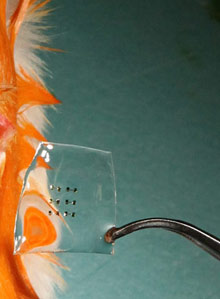Biodegradable silk electronics to improve implants

Building on advancements in foldable ultra-thin flexible circuits, researchers at the University of Illinois at Urbana-Champaign, and Tufts University have developed electronics that almost completely dissolve inside the body by incorporating silk.
Technology Review reports that the research group has demonstrated arrays of transistors made on thin films of silk.
Typically, implanted electronics are encased to protect them from the body, but these new electronics don't need such protection. The silk allows for the electronics to conform to biological tissue as it melts away over time. And the thin silicon circuits left behind don't cause irritation because they are just nanometers thick.
The image on the left depicts the implantable device. It consists of a clear silk film, about one centimeter squared, with six silicon transistors on its surface. The device can be implanted in mice like the one in this image and the silk degrades over time. It causes no harm to the animal. (The orange liquid on the hair is a disinfectant used during the surgery.)
Here is how the article describes how the devices are made:
To make the devices, silicon transistors about one millimeter long and 250 nanometers thick are collected on a stamp and then transferred to the surface of a thin film of silk. The silk holds each device in place, even after the array is implanted in an animal and wetted with saline, causing it to conform to the tissue surface.
Approved by the U.S. Food and Drug Administration for medical implants, silk is broken down completely by the body into harmless by-products. Therefore, the implanted devices should have no adverse effects. In animals, the researchers say, that is the case. And the performance of the transistors on silk inside the body doesn't suffer, they note.
"Silk is mechanically strong enough to act as a support, but if you pour water on it, it conforms to the tissue surface," says Fiorenzo Omenetto, a professor of bioengineering at Tufts University in Medford, MA, who is involved in the research of bio-compatible devices.
Silicon, however, doesn't offer the same level of bio-compatibility. But studies have shown that it does not cause the body harm, especially when the pieces used are minimized. Even the electrical connections made of gold and titanium are bio-compatible, but not biodegradable, the TR article notes.
The next step for the research group is to design electrodes built on silk as interfaces for the nervous system, which could integrate much better with biological tissues than existing electrodes.
"The electrodes might be wrapped around individual peripheral nerves to help control prostheses. Arrays of silk electrodes for applications such as deep-brain stimulation, which is used to control Parkinson's symptoms, could conform to the brain's crevices to reach otherwise inaccessible regions," writes TR.
The team recently published their findings in the journal Applied Physics Letters.
